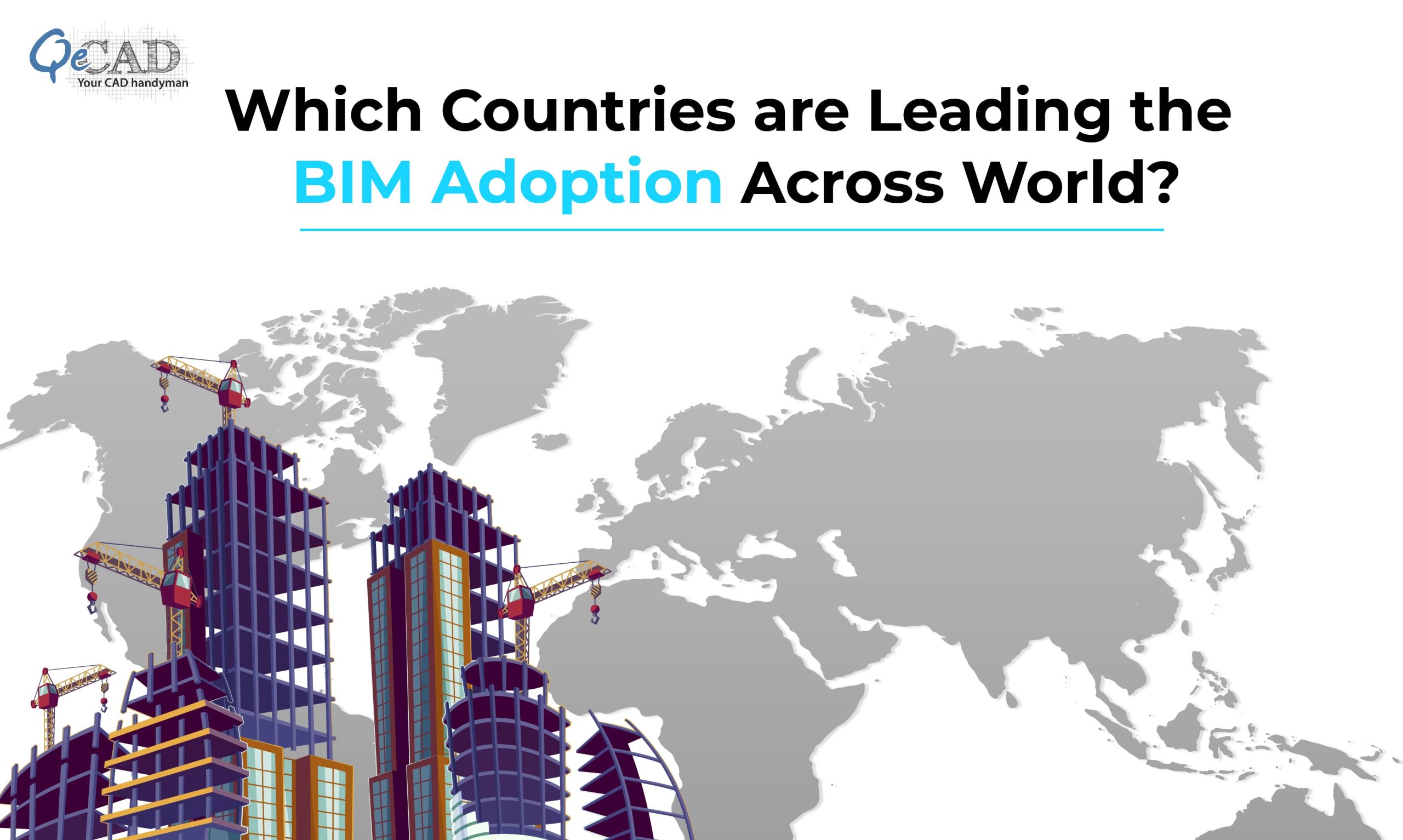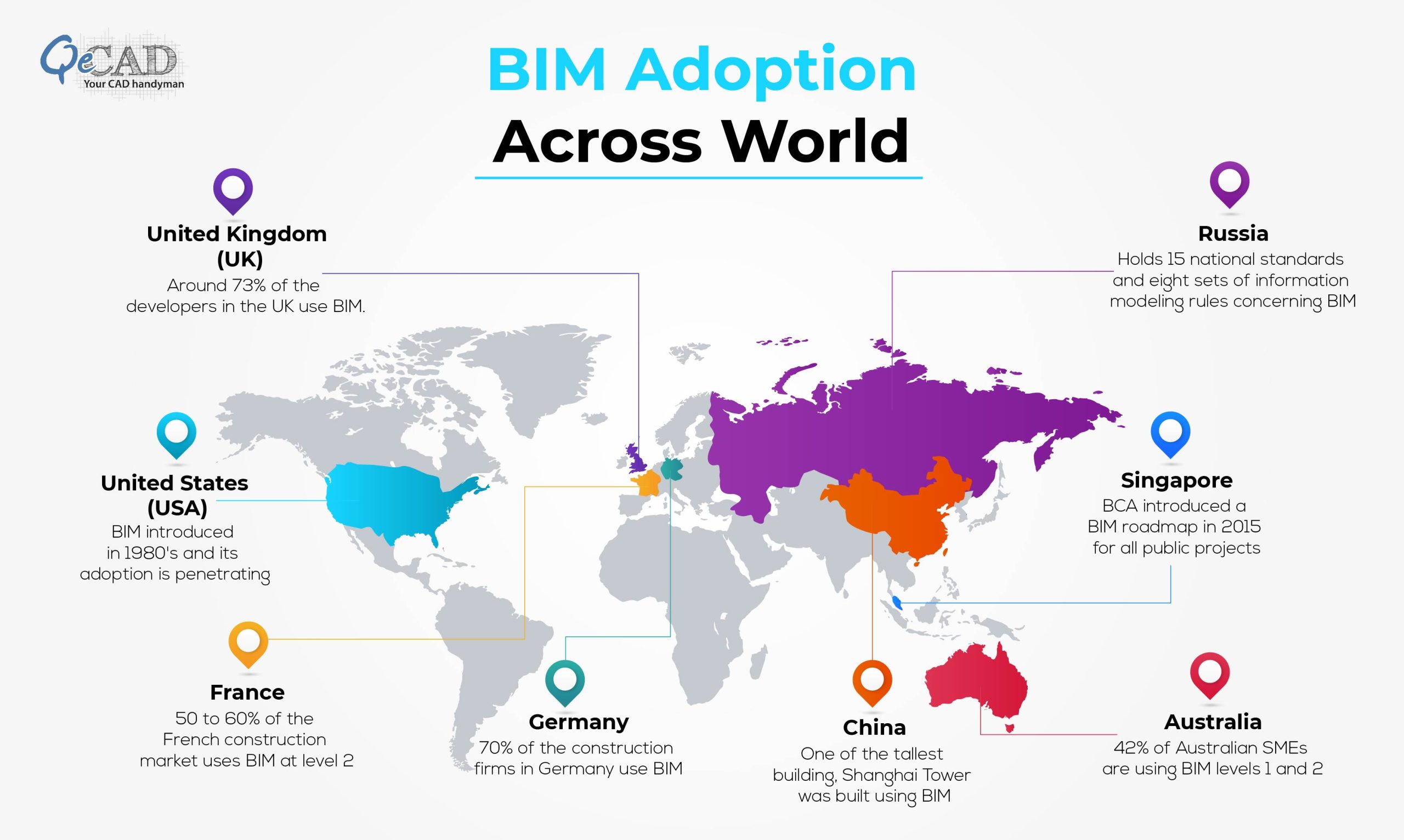
With advanced technology tapping around the globe in almost every industry, the AEC industry is also embracing it. The use of Drones in construction, digital twins, modular construction, additive manufacturing, smart cities, and BIM modeling are a few examples of integrating the latest technology in the AEC sector. Among these trends, the most common and mandatory one is BIM Modelling, which has become the need of the hour. Many firms around the countries have started adopting BIM Services to outcompete the market with increasing urbanization and modern construction. Implementing BIM in the construction process is gaining momentum, and adopting BIM can create a strong foundation for infrastructural projects in the countries, making it outstanding across the globe.
Since BIM holds such importance in the AEC industry, let’s see how different countries are making their way toward adopting it.
1) United States (USA)
- They have been the pioneers and creators of BIM since the 1970s.
- As per GSA, BIM has been mandatory for public projects budgeting $ 5 million or above in many regions since 2003.
- US Navy and Army use BIM to design and construct their facilities and manage their assets.
- Canada is on the path of the US following this advancing technology quickly. The BIM standard for building Smart Canada has been granted by the AECO community, which is driving BIM adoption in this region at a fast pace.
- Considering South America, Colombia, Peru, and Chile have strategic plans to push BIM while Venezuela, Ecuador, and Costa Rica are still lagging in BIM adoption.
- Countries like Argentina, Brazil, and Mexico are slowly evolving to create awareness and train AEC people on BIM and its benefits.
- BIM is the mainstream of the USA Construction Industry as architects, contractors, and engineers effectively use it.
2) United Kingdom (UK)
- UK construction firms first implemented BIM in the 1980s.
- Heathrow Airport Reconstruction was the UK’s first project to use BIM.
- Since April 2016, UK Government has made it mandatory to use BIM level 2 on Public or state-funded projects, while private projects are still optional. This is the reason for the massive push for BIM adoption in the UK.
- The adoption of BIM by large firms is apparent, while only some small firms have started with BIM implementation. 62% of the small-scale firms and 80 % of the large-scale firms in the UK are actively using BIM, as per the statistics from NBS. Around 73% of the developers in the UK use BIM.
- BIM is the future of construction in the UK and is being adopted rapidly.
3) France
- BIM became popular in France in 2006-07 but was first implemented in 2010.
- At first, France did not introduce any BIM mandates, yet 35% of developers in France use BIM; later, in 2018, BIM Plan 2022 was launched by the French Government to integrate BIM into the construction workflows.
- Almost 50 to 60% of the French construction market uses BIM at level 2 in their projects.
- Recently, a Digital Transition Plan for Construction has been pushed in the country, aiming to integrate and implement BIM methodology throughout the regions fully.
- It is difficult for construction firms to use BIM due to scattered BIM standards and formats.
4) Germany
- BIM was implemented in the first German construction project in 2006.
- Around 70% of the construction firms in Germany use BIM, most of which are architects and design firms.
- BIM implementation has been mandatory for projects around €100 million and above since 2017.
- BIM usage has become a compulsion for public contracts relevant to infrastructure since 2020.
- Most German firms use BIM at Level 2, but some high-scale firms have also implemented level 3 in their projects.
- Germany is among the top countries to develop and introduce a National BIM strategy and to train and consult BIM projects.
5) Russia
- BIM was officially used in Russia in 2014, whereas its official presence was in 2019 in Russian construction.
- A set of rules relevant to BIM was introduced in 2018, and later in 2020, it got approved as the standard for forming and maintaining BIM.
- Considering legislation standardizing and mandating BIM, Russia is topping the chart with 15 national standards and eight sets of information modeling rules in the country.
- Since 2022, BIM technology in government projects has become a mandate.
- Currently, BIM technology is used by real estate developers and construction companies across Moscow, St. Petersburg, Kazan, Ufa, and Yekaterinburg.
- For Russia, Government rules and consistent support relevant to BIM are acting as a catalyst for fast penetration of BIM technology in Russian construction.

6) Australia
- In Australia, the first BIM-based project was executed in 2010.
- As of 2016, the Australian Government made it mandatory to implement BIM in all Government funded infrastructure projects worth $50 million and above.
- Queensland has swayed to the front in terms of BIM implementation. The Queensland Department of Infrastructure, Local Government and Planning has released a guide for using BIM in road infrastructures.
- The Sydney Metro project was also implemented successfully with the implementation of BIM.
- In Australia, large-scale companies have witnessed the benefits of BIM, while small firms still need help with issues due to a lack of understanding.
- According to a report by ResearchGate, currently, around 42% of Australian SMEs are using BIM levels 1 and 2, and approximately 5% have tried BIM level 3.
- The Australian construction industry will need to incorporate a high level of BIM similar to the US and the UK.
7) Singapore
- In Singapore, BIM was introduced in 2010.
- Singapore’s building and construction authority (BCA) introduced a BIM roadmap in 2015 for all public projects.
- In 2015, the building and construction authority implemented BIM e-submission to cater to projects more significant than 5000 sq. mts.
- Singapore focuses on developing a smart nation by implementing BIM as a key technology in both public and private construction projects.
8) China
- BIM was introduced and executed in China in 2016.
- The Ministry of Housing and Urban-Rural Development has been continuously making efforts to implement BIM technology since 2001.
- The first project that implemented BIM technology was the Shanghai tower which is a 128-story building is recognized as the tallest in China.
- Considering BIM Standards, Hong Kong has high BIM adoption rate than the UK.
- According to ResearchGate, BIM is becoming a vital tool for success concerning the sustainable transformation of China’s construction industry.
Conclusion: BIM adoption Across Countries is becoming Stagnant
Above listed are a few of the major countries and their statistics about BIM adoption and implementation. In addition, many European countries like Norway, Denmark, Finland, Austria, and Sweden use BIM level 2 in their construction and design. Countries like UAE, Japan, and India also penetrate the market with BIM usage. BIM has been of great help to the construction industries, irrespective of borders, to improve and streamline their building design and construction process. It is marvelous to see the use of BIM technology worldwide, and the drastic shift toward its adoption is becoming stagnant. The ones still lagging need to chase the competition by outsourcing the BIM services for better understanding and implementation. QeCAD is a BIM company delivering efficient BIM and CAD solutions to enhance your building process. Our solutions are scalable, cost-effective, and as per global construction standards.
